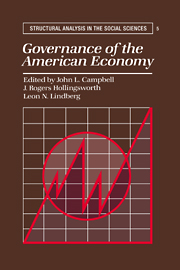Book contents
- Frontmatter
- Contents
- List of figures
- List of tables
- List of contributors
- Preface
- I Conceptual and historical foundations
- II Empirical studies of governance transformations in the United States
- 3 Transformations in the governance of the American telecommunications industry
- 4 Contradictions of governance in the nuclear energy sector
- 5 The statist evolution of rail governance in the United States, 1830–1986
- 6 Governance of the steel industry: What caused the disintegration of the oligopoly?
- 7 Governance of the automobile industry: The transformation of labor and supplier relations
- 8 The dairy industry: From yeomanry to the institutionalization of multilateral governance
- 9 Economic governance and the American meatpacking industry
- 10 The invisible hand in healthcare: the rise of financial markets in the U.S. hospital industry
- III Theoretical evaluation of the empirical cases
- References
- Index
7 - Governance of the automobile industry: The transformation of labor and supplier relations
Published online by Cambridge University Press: 21 March 2010
- Frontmatter
- Contents
- List of figures
- List of tables
- List of contributors
- Preface
- I Conceptual and historical foundations
- II Empirical studies of governance transformations in the United States
- 3 Transformations in the governance of the American telecommunications industry
- 4 Contradictions of governance in the nuclear energy sector
- 5 The statist evolution of rail governance in the United States, 1830–1986
- 6 Governance of the steel industry: What caused the disintegration of the oligopoly?
- 7 Governance of the automobile industry: The transformation of labor and supplier relations
- 8 The dairy industry: From yeomanry to the institutionalization of multilateral governance
- 9 Economic governance and the American meatpacking industry
- 10 The invisible hand in healthcare: the rise of financial markets in the U.S. hospital industry
- III Theoretical evaluation of the empirical cases
- References
- Index
Summary
Until the 1970s the U.S. automobile industry was largely insulated from global competition. Its products, like those of most domestic manufacturers, were designed according to the specific demands and characteristics of the domestic market. Exports were seen as a bonus to normal business operations and, therefore, did not require special attention (Wilkins and Hill 1964: 376). Instead, foreign markets were served primarily by the domestic producers' foreign subsidiaries with largely autonomous product developments. During the last decade, however, the domestic supremacy of the three major U.S. manufacturers, the so-called Big Three, General Motors, Ford, and Chrysler, was challenged. Starting in the small car market, foreign producers were able to capture ever-increasing market shares. Since the mid–1980s, the investment in domestic assembling facilities by some foreign auto makers has meant that not even import restrictions or manipulations of the value of the U.S. dollar are effective tools for insulating the Big Three's U.S. operations from foreign competition. Domestic automobile production has become permanently integrated into global circuits of competition.
The initial difficulties faced by the U.S. automobile industry in adjusting to this new competitive environment became the subject of public debate. As Lawrence and Dyer (1983: 17) pointedly remarked, “[i]n a crisis of such magnitude, there is plenty of blame to go around, and there has been no shortage of critics (inside and outside the industry) offering opinions as to what went wrong.” In the meantime, the Big Three have managed a spectacular comeback, but doubts about their competitiveness remain.
- Type
- Chapter
- Information
- Governance of the American Economy , pp. 209 - 235Publisher: Cambridge University PressPrint publication year: 1991
- 1
- Cited by



